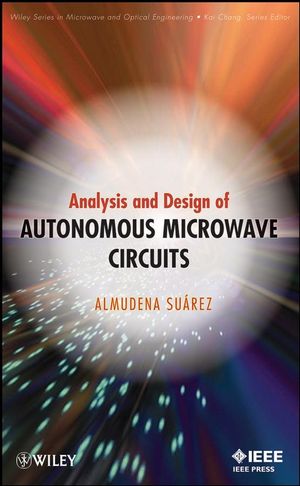Analysis and Design of Autonomous Microwave CircuitsISBN: 978-0-470-05074-3
Hardcover
704 pages
January 2009, Wiley-IEEE Press
 This is a Print-on-Demand title. It will be printed specifically to fill your order. Please allow an additional 10-15 days delivery time. The book is not returnable.
|
||||||
1. Oscillator Dynamics.
1.1. Introduction.
1.2. Operational Principle of Free-Running Oscillators.
1.3. Impedance-Admittance Analysis of an Oscillator.
1.4. Frequency-Domain Formulation of an Oscillator Circuit.
1.5. Oscillator Dynamics.
1.6. Phase Noise.
2. Phase Noise.
2.1. Introduction.
2.2. Random Variable and random Processes.
2.3. Noise Sources in Electronic Circuits.
2.4. Derivation of the Oscillator Noise Spectrum Using Time-Domain Analysis.
2.5. Frequency-Domain Analysis of a Noisy Oscillator.
3. Bifurcation Analysis.
3.1. Introduction.
3.2. Representation of Solutions.
3.3. Bifurcations.
4. Injected Oscillators and Frequency Dividers.
4.1. Introduction.
4.2. Injection-Locked Oscillators.
4.3. Frequency Dividers.
4.4. Subharmonically and Ultrasubharmonically Injection-Locked Oscillators.
4.5. Self-Oscillating Mixers.
5. Nonlinear Circuit Simulation.
5.1. Introduction.
5.2. Time-Domain Integration.
5.3. Fast Time-Domain Techniques.
5.4. Harmonic Balance.
5.5. Harmonic Balance Analysis of Autonomous and Synchronized Circuit.
5.6. Envelope Transient.
5.7. Conversion Matrix Approach.
6. Stability Analysis Using Harmonic Balance.
6.1. Introduction.
6.2. Local Stability Analysis.
6.3. Stability Analysis of Free-Running Oscillators.
6.4. Solution Curves Versus a Circuit Parameter.
6.5.Global Stability Analysis.
6.6. Bifurcation Synthesis and Control.
7. Noise Analysis Using Harmonic Balance.
7.1. Introduction.
7.2. Noise in Semiconductor Devices.
7.3. Decoupled Analysis of Phase and Amplitude Perturbations in a Harmonic Balance System.
7.4. Coupled Phase and Amplitude Noise Calculation.
7.5. Carrier Modulation Approach.
7.6. Conversion Matrix Approach.
7.7. Noise in Synchronized Oscillators.
8. Harmonic Balance Techniques for Oscillator Design.
8.1. Introduction.
8.2. Oscillator Synthesis.
8.3. Design of Voltage-Controlled Oscillators.
8.4. Maximization of Oscillator Efficiency.
8.5. Control of Oscillator Transients.
8.6. Phase Noise Reduction.
9. Stabilization Techniques for Phase Noise Reduction.
9.1. Introduction.
9.2. Self-Injection Topology.
9.3. Use of High-Q Resonators.
9.4. Stabilization Loop.
9.5. Transistor-Based Oscillators.
10. Coupled-Oscillator Systems.
10.1. Introduction.
10.2. Oscillator Systems with Global Coupling.
10.3. Coupled-Oscillator Systems for Beam Steering.
11. Simulation Techniques for Frequency-Divider Design.
11.1. Introduction.
11.2. Types of frequency dividers.
11.3. Design of Transistor-Based Regenerative Frequency Dividers.
11.4. Design of Harmonic Injection Dividers.
11.5. Extension of the Techniques to Subharmonic Injection Oscillators.
12. Circuit Stabilization.
12.1. Introduction.
12.2. Unstable Class AB Amplifier Using Power Combiners.
12.3. Unstable Class E/F Amplifier.
12.4. Unstable Class E Amplifier.
12.5. Stabilization of Oscillator Circuits.
12.6. Stabilization of Multifunction MMIC Chips.
Index.



